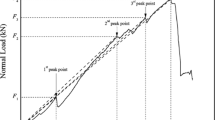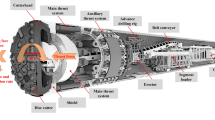Abstract
Rock strength is one of the most important parameters in geotechnical engineering. During excavation using a tunnel boring machine (TBM), a rapid and effective method to estimate rock strength is needed. The TBM muck produced during excavation contains blocky fragments which are suitable for a point load test (PLT). To use the PLT on blocky fragments to estimate rock strength, it is necessary to find the relation between the point load strength (PLS) of blocky fragments and uniaxial compressive strength (UCS) of surrounding rocks. In the present study, PLT was performed on both blocky fragments and core samples of limestone for the Yinsong Water Conveyance Project, China. The UCS of limestone was acquired. The PLS of blocky fragments and core samples was compared. The results show that the blocky fragments’ PLS is lower than that of core samples; the declining ratio depends on the fractured degree of sampling sites; blocky fragments with width and thickness in a certain range are suitable for estimating rock strength; and when the size of the blocky fragment exceeds a certain range, it means the blocky fragment was not generated from the tunnel face. The limestone core samples simultaneously drilled from side wall have an average conversion factor from PLS to UCS of 24.61. The mean conversion factor from PLS of blocky fragments to UCS of limestone in the present study is 40.38.








Similar content being viewed by others
References
ASTM (2014) Standard test methods for compressive strength and elastic moduli of intact rock core specimens under varying states of stress and temperatures: D7012–14. Annual book of ASTM standards. ASTM International, West Conshohocken
Barton N (2000) Tunnelling in jointed and faulted rock. A.A. Balkema, Rotterdam
Basu A, Aydin A (2006) Predicting uniaxial compressive strength by point load test: significance of cone penetration. Rock Mech Rock Eng 39(5):483–490
Basu A, Kamran M (2010) Point load test on schistose rocks and its applicability in predicting uniaxial compressive strength. Int J Rock Mech Min Sci 47(5):823–828
Bieniawski ZT (1975) Point load test in geotechnical practice. Eng Geol 9(1):1–11
Bilgin N (2016) An appraisal of TBM performance in Turkey in difficult ground conditions and some recommendations. Tunn Undergr Sp Tech 57:265–276
Broch E, Franklin JA (1972) The point load strength test. Int J Rock Mech Min Sci Geomech Abstr 9(6):669–697
Brook N (1985) The equivalent core diameter method of size and shape correction in point load testing. Int J Rock Mech Min Sci Geomech Abstr 22(2):61–70
Cargill JS, Shakoor A (1990) Evaluation of empirical methods for measuring the uniaxial compressive strength of rock. Int J Rock Mech Min Sci Geomech Abstr 27(6):495–503
Chau KT, Wong RHC (1996) Uniaxial compressive strength and point load strength. Int J Rock Mech Min Sci Geomech Abstr 33(2):183–188
CRSRI (Changjiang River Scientific Research Institute) (2013) Standard for Test Method of Engineering Rock Mass
Edet AE, Teme SC (1990) Strength classification of some nigerian limestones using the point load testing technique. Bull Eng Geol Environ 41(1):97–106
Farrokh E, Rostami J (2008) Correlation of tunnel convergence with TBM operational parameters and chip size in theGhomroud tunnel, Iran. Tunn Undergr Sp Tech 23(6):700–710
Fener M, Kahraman S, Bilgil A, Gunaydin O (2005) A comparative evaluation of indirect methods to estimate the compressive strength of rocks. Rock Mech Rock Eng 38(4):329–343
ISRM (1985) Suggested method for determining point load strength. Int J Rock Mech Min Sci Geomech Abstr 22(2):51–60
Jaeger J, Hoskins E (1966) Stresses and failure in rings of rock loaded in diametral tension or compression. Br J Appl Phys 17(5):685–692
Karaman K, Kaya A, Kesimal A (2015) Use of the point load index in estimation of the strength rating for the RMR system. J Afr Earth Sci 106:40–49
Kaya A, Karaman K (2016) Utilizing the strength conversion factor in the estimation of uniaxial compressive strength from the point load index. Bull Eng Geol Environ 75(1):341–357
Kohno M, Maeda H (2012) Relationship between point load strength index and uniaxial compressive strength of hydrethermally altered soft rocks. Int J Rock Mech Min Eng 50:147–157
Kong XX, Liu QS, Zhao YF, Pan YC, Liu JP (2015) Numerical modeling of the effects of joint orientation on rock fragmentation by TBM cutters. J China Coal Soc 40(6):1257–1262 (in Chinese)
Lee SW, Chang SH, Park KH, Kim CY (2011) TBM performance and development state in Korea. Procedia Engineering 14(1):3170–3175
Liu B, Liu Z, Li S, Nie L, Su M, Sun H, Fan K, Zhang X, Pang Y (2017) Comprehensive surface geophysical investigation of karst caves ahead of the tunnel face: a case study in the Xiaoheyan section of the water supply project from Songhua River, jilin, China. J Appl Geophys 144:37–49
Li D, Wong LNY (2013) Point load test on meta-sedimentary rocks and correlation to UCS and BTS. Rock Mech Rock Eng 46(4):889–896
Liu Q, Huang X, Gong Q, Du L, Pan Y, Liu J (2016) Application and development of hard rock TBM and its prospect in China. Tunn Undergr Sp Tech 57:33–46
Rusell AR, Wood DM (2009) Point load tests and strength measurements for brittle spheres. Int J Rock Mech Min Sci 46(2):272–280
Saroglou H, Tsiambaos G (2006) Point load strength determination of anisotropic rocks. In: Cotthem V, Chailier R, Thimus JF, Tshibangu JP (eds) EUROCK 2006-multiphysics coupling and long term behaviour in rock mechanics. Taylor & Francis Group, London
Serati M, Alehossein H, Erarslan N, Williams DJ (2013) 3D elastic solutions for point load and Brazilian indirect tensile strength tests. Proccedings of the 2013 ISRM International Symposium (EUROCK 2013), Wroclaw, Poland, 21–26 September, 887–892
Serati M, Alehossein H, Williams DJ (2014) 3D elastic solutions for laterally loaded discs: generalised Brazilian and point load tests. Rock Mech Rock Eng 47(4):1087–1101
Serati M, Alehossein H, Williams DJ (2016) Theoretical treatment of disc cutters subjected to general cutting forces. J Eng Math 100(1):141–165
Smith H (1997) The point load test for weak rock in dredging applications. Int J Rock Mech Min Sci 34:3–4
Vallejo LE, Walsh RA, Robinson MK (1989) Correlation between unconfined compressive and point load strength for appalachian rocks. In the proceeding of the 30th U.S. symposium on rock mechanics: 461-468
Wijk G (1980) The point load test for the tensile strength of rock. Geotech Test J 3:49–54
Yao JC (1969) Long cylindrical tube subjectedto two diametrically opposite loads. Aeronaut Q 20:365–381
Zhang XP, Wong LNY (2012) Cracking processes in rock-like material containing a single flaw under uniaxial compression- a numerical study based on parallel bonded-particle model approach. Rock Mech Rock Eng 45:711–737
Zhang XP, Wong LNY (2013) Crack initiation, propagation and coalescence in rock-like material containing two flaws: a numerical study based on bonded-particle model approach. Rock Mech Rock Eng 46(5):1001–1021
Zhang XP, Wu S, Afolagboye LO, Wang S, Han G (2016) Using the point load test to analyze the strength anisotropy of quartz mica schist along exploration adit. Rock Mech Rock Eng 49:1967–1975
Zhang XP, Zhang Q, Wu S (2017) Acoustic emission characteristics of the rock-like material containing a single flaw under different compressive loading rates. Comput Geotech 83:83–97
Zhang XP, Ji PQ, Liu QS, Liu Q, Zhang Q, Peng ZH (2018) Physical and numerical studies of rock fragmentation subject to wedge cutter indentation in the mixed ground. Tunn Undergr Sp Tech 71:354–365
Acknowledgements
The authors would like to acknowledge the support provided by the National Basic Research Program of China (973 Program) (Grant Nos. 2014CB046904 and 2015CB058102) and the National Natural Science Foundation of China (Grant No. 41130742).
Author information
Authors and Affiliations
Corresponding author
Rights and permissions
About this article
Cite this article
Liu, QS., Zhao, YF. & Zhang, XP. Case study: using the point load test to estimate rock strength of tunnels constructed by a tunnel boring machine. Bull Eng Geol Environ 78, 1727–1734 (2019). https://doi.org/10.1007/s10064-017-1198-x
Received:
Accepted:
Published:
Issue Date:
DOI: https://doi.org/10.1007/s10064-017-1198-x




